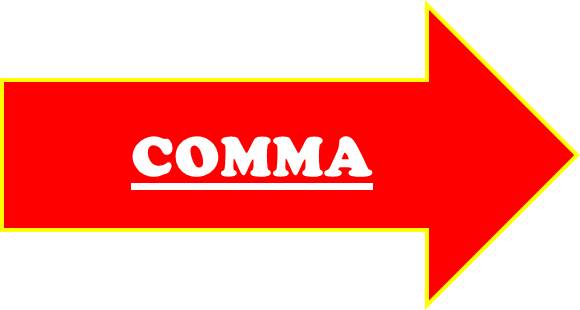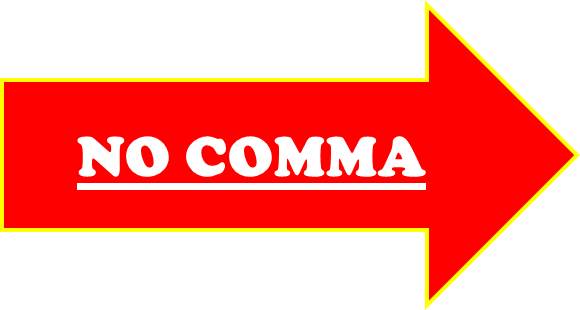|




|
|
         
|
|
|

-
COMMON
KNOWLEDGE:
-
“Common knowledge includes information
widely available in reference works,
such as basic biographical facts about
prominent persons and the dates and
circumstances of major historical
events” (MLA 10).
-
this
does get a bit confusing:
-
of
course, if you are ever unsure if you
need to cite, it is better to err on the
side of caution...& CITE
-
PLAGIARISM & COMMON KNOWLEDGE.PPT (.pdf)
|
|
|
*Cite IMMEDIATELY, not EVENTUALLY* |
-
Cite the
sentence sentence of borrowed information.
-
Do NOT
cite an entire paragraph:
-
Which
sentence has the borrowed info?
-
Which
ideas come from you & which come from
the source?
-
What
if you have info coming from different
locations within that source?
-
What
if you have multiple sources within that
paragraph?
-
SO...
-
every time
you borrow information
-
cite it
-
immediately after that sentence
|
|
|
|
Quotation Marks + space +
Parentheses + Period |
-
NAME:
-
PERIOD:
|
|
Author’s Last Name
+
space
+
Page Number |
*CORE ELEMENTS*
(1)
AUTHOR
|
-
just the Last Name
-
(when not used in the Lead-In
Expression)
|
(2)
PAGE NUMBER
|
-
no
“p.” or “pp” for page numbers
-
just the numeral
-
found in print versions of
books, magazines, journals,
newspapers
-
seen onscreen with numbered
pages, .pdf files
|
|
*EXAMPLE* |
-
(Smith 679).
-
*no punctuation between
elements…ordinarily
|
|
|
-
*BONUS INFO*
-
Sometimes it is
necessary to add more information than just
these basics.
-
What if your source has no author?
-
What if you have more than 1 source by that
author?
-
What if you have more than 1 Smith on your
WC page?
-
What if you have more than 1 article from
that site?
-
How
will readers be able to make sense of your
citation?
-
Paragraph 6 in which Smith article?
-
Is 'Causes' in Jayne Smith's or Roger
Smith's article?
-
Page 52 in which CDC article?
-
This is when you need to
add "bonus info" into your in-text citation.
*(a) Bonus Info: AUTHORS*
0 AUTHORS
|
use the
"Article Title" |
-
when a
source has
NO AUTHOR—
-
use the
next item in the Bibliographic
Citation
(the Works Cited page entry)
-
usually it is the
“Article Title”
(but could be the
Book Title)
-
the title can be
shortened/truncated if it is too
long
-
(*as long as it does not
create confusion with
another title)
-
EXAMPLE:
-
(“The Causes and Effects of
Fibromyalgia” 45).
-
(Neurological Disorders
462).
-
*keep the "quotation
marks" around article
titles
-
*keep the italics
of the book title
|
2 AUTHORS
|
add the 2nd
author's Last Name |
-
when
a source has
2
AUTHORS--
-
Last Name + and + Last Name
-
(not an ampersand -- &)
-
EXAMPLE:
-
(Lewis and Clark 557).
-
(Martin and Lewis 2).
|
3+ AUTHORS
|
add et al. |
-
when a source has
3 or
more AUTHORS--
-
Last
Name of the 1st author
indicated in the source + et
al.
(“and others”)
-
the
“al” needs a period after it
because it is an
abbreviation
-
EXAMPLE:
-
(Jeter, et al. 2).
-
(Fouts,
et al. 14).
|
2 + WORKS
by the SAME AUTHOR
|
add the
"Article Title"
 |
-
when you have
2 or more Works by the SAME
AUTHOR--
-
Last Name + comma +
Source
-
EXAMPLE:
-
(Loman, “Causes of
Depression” 213).
-
(Loman, “Overcoming
Depression” 89).
|
2 + WORKS
w/o AUTHORS
from the
SAME SOURCE
|
add the
Site Name
 |
-
when you have
2 or more Works that do NOT
have authors from the SAME SITE
or SOURCE--
-
"Article Title" + comma,
inside the QM + Source
-
EXAMPLE:
-
("Gluttony," 7DeadlySins.org,
par.2).
-
("Avarice,"
7DeadlySins.org, par.9).
|
2+ AUTHORS
with the SAME LAST NAME
|
add the 1st
initial |
-
when you have
2 or more AUTHORS with the
SAME LAST NAME--
-
1st initial + period +
Last Name
-
(use the full 1st name
if the initials are the
same)
-
EXAMPLE:
-
(B. Clinton 98).
-
(H. Clinton 114).
|
*(b) Bonus Info:
Locators*
-
Since readers often
need to find the
original of a thought or quote & its original context, they need to be able to find,
easily
and quickly, where it is located in the source document.
-
SO
-
To
accomplish this, we place
page
numbers
-- as shown above -- in the parenthetical citation
to help readers painlessly find the original, without having to read
the entire source.
-
BUT
-
If no
page numbers appear in or on the original – and this is particularly
the case with electronic sources such as
Web sites – then
you cannot rely upon the page numbers supplied by the printers
because each printer’s settings are different.
-
SO
-
Thus, you will
use some other locator -- such as
*NO PAGE NUMBERS*
PARAGRAPH NUMBERS
|
-
numbered onscreen
-
Last Name + comma + par.#
-
EXAMPLE:
-
(Smith and Wesson, par.5).
-
(Smith and Wesson,
pars.1-3).
|
CHAPTERS, SECTIONS, PARTS, BOOKS

|
-
numbered onscreen
-
Last Name + comma + ch.#
-
Last Name + comma + sec.#
-
Last Name + comma + pt.#
-
Last Name + comma + bk.#
-
EXAMPLE:
-
(Thompson, ch.2).
-
(Ruger, secs.7-8).
-
(Colt, pts.44-45).
-
(Winchester, bk.9).
|
VIDEO TIME CODES

|
-
for audio or video
TIME-BASED MEDIA,
use the TIME CODE
for the location
-
videos, movies, podcasts
-
songs, recorded lectures
-
hour + colon + minute + colon +
second
-
EXAMPLE:
-
(Fight Club
00:54:23).
-
(Durden 01:32:48).
|
*NO NUMBERED LOCATION INDICATORS*
NO NUMBERED LOCATIONS
|
-
instead, describe the location
in the
LEAD-IN EXPRESSION
-
EXAMPLE:
-
In the third paragraph of
Ebert’s review, ….
-
Under the subheading
‘Symptoms,’….
|

|
*BASIC IN-TEXT
CITATION SET UP*
|
SOURCE with
an AUTHOR |
SOURCE
without an AUTHOR |
-
(Smith 241).
-
(Smith, par.3).
-
(Smith,
ch.19).
|
-
("Anorexia Nervosa" 648).
-
("Anorexia Nervosa," par.8).
-
("Anorexia Nervosa," ch.7).
|
-
Basic PC
info =
-
Bonus PC
Info =
-
"Article Title" (in lieu
of author)
-
numbers of paragraphs, chapters, books, parts, sections
(in lieu of page numbers)
|
**The
1st
item (correctly) on the
Works Cited page
= The
1st
item in the
Parenthetical Citation** |


|
|
|
BIBLE |
-
italicize the version
name
-
do NOT italicize books of the
Bible
-
abbreviate the Book Title +
period after an abbrev.
-
no
abbreviations for “chapter” or
“verse”
-
Version Name + comma + Bk. Title
+ period (abbreviation) +
chapter + period + verse/s
-
EXAMPLE:
-
(LeBron James Version,
Rev. 23.23).
-
(New Boring Sanitized
Version, Gen. 1.1-3).
|
-
the
1st time
you cite from the Bible, you
must include the
specific version
you are
using
-
some versions include the KJV, New King
James Version, New American Standard
Version, New International Version, New
Living Translation, English Standard
Version, Wycliffe New Testament
-
and that's just a few of those printed in
English!
-
(King James Version, Rom. 8.28-29).
-
for all
subsequent
citations
from that
particular version of the Bible, you do
not need this addition
-
(Ezek. 1.5-10).
|
MLA Abbreviations for Books of the Bible: |
*Do NOT underline or
italicize books of the Bible*
|
OLD TESTAMENT |
NEW TESTAMENT |
|
Gen. |
Genesis |
Eccles. |
Ecclesiastes |
|
Exod. |
Exodus |
Song of Sol. (also Cant.) |
Song of Solomon (also
Canticles) |
|
Lev. |
Leviticus |
Isa. |
Isaiah |
|
Num. |
Numbers |
Jer. |
Jeremiah |
|
Deut. |
Deuteronomy |
Lam. |
Lamentations |
|
Josh. |
Joshua |
Ezek. |
Ezekiel |
|
Judg. |
Judges |
Dan. |
Daniel |
|
Ruth |
Ruth |
Hos. |
Hosea |
|
1 Sam. |
1 Samuel |
Joel |
Joel |
|
2 Sam. |
2 Samuel |
Amos |
Amos |
|
1 Kings |
1 Kings |
Obad. |
Obadiah |
|
2 Kings |
2 Kings |
Jon. |
Jonah |
|
1 Chron. |
1 Chronicles |
Mic. |
Micah |
|
2 Chron. |
2 Chronicles |
Nah. |
Nahum |
|
Ezra |
Ezra |
Hab. |
Habakkuk |
|
Neh. |
Nehemiah |
Zeph. |
Zephaniah |
|
Esth. |
Esther |
Hag. |
Haggai |
|
Job |
Job |
Zech. |
Zechariah |
|
Ps. |
Psalms |
Mal. |
Malachi |
|
Prov. |
Proverbs |
|
|
|
|
Matt. |
Matthew |
1 Tim. |
1 Timothy |
|
Mark |
Mark |
2 Tim. |
2 Timothy |
|
Luke |
Luke |
Tit. |
Titus |
|
John |
John |
Phil. |
Philemon |
|
Acts |
Acts |
Heb. |
Hebrews |
|
Rom. |
Romans |
Jas. |
James |
|
1 Cor. |
1 Corinthians |
1 Pet. |
1 Peter |
|
2 Cor. |
2 Corinthians |
2 Pet. |
2 Peter |
|
Gal. |
Galatians |
1 John |
1 John |
|
Eph. |
Ephesians |
2 John |
2 John |
|
Phil. |
Philippians |
3 John |
3John |
|
Col. |
Colossians |
Jude |
Jude |
|
1 Thess. |
1 Thessalonians |
Rev. (also Apoc.) |
Revelation (also Apocalypse) |
|
2 Thess. |
2 Thessalonians |
|
|

|

|
|
ANTHOLOGIZED WORKS:
-
PROSE:
-
Author +
space + page number + semicolon
+ additional ID info (chapter,
section, act,…)(each separated by a comma)
-
(O’Connor
239; pt.4).
-
(Roberts
611; ch.2, sect.4).
-
VERSE, POETRY:
-
no page
numbers
-
Work
+ space + division (act, scene, canto, book, part) + period
+ line number
-
line
number—
-
(Macbeth
5.5.19-28).
-
(Odyssey
2.111 ).
-
(Crane
5-13).
-
*BUT*
-
if an
anthologized work has no line
numbers in it
-
then use
the page number
-
(Roberts
192).
-
if the
work is a 1-page poem
-
BONUS
INFO
for In-Text Citations of Anthologized Works:
-
Author +
page number + semicolon + divisions with commas (if those
divisions are numbered)
-
(Smith
193; ch.2, sec.7).
|
|
|
|